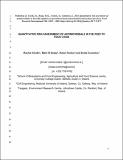| dc.contributor.author | Clarke, Rachel | |
| dc.contributor.author | Healy, Mark G. | |
| dc.contributor.author | Fenton, Owen | |
| dc.contributor.author | Cummins, Enda | |
| dc.date.accessioned | 2018-03-26T11:47:32Z | |
| dc.date.issued | 2017-12-30 | |
| dc.identifier.citation | Clarke, Rachel, Healy, Mark G., Fenton, Owen, & Cummins, Enda. (2018). Quantitative risk assessment of antimicrobials in biosolids applied on agricultural land and potential translocation into food. Food Research International, 106, 1049-1060. doi: https://doi.org/10.1016/j.foodres.2017.12.072 | en_IE |
| dc.identifier.issn | 1873-7145 | |
| dc.identifier.uri | http://hdl.handle.net/10379/7233 | |
| dc.description.abstract | The use of biosolids as a fertiliser may be an indirect route for contaminants into the food chain. One of the main concerns regarding the spreading of biosolids on agricultural land is the potential uptake of contaminants into plants which may bio-transfer into grazing animals that supply the food chain directly (e.g. meat and milk) and hence are subsequently consumed. The aim of this project was to create a quantitative risk assessment model to estimate the fate and translocation of triclosan (TCS) and triclocarban (TCC) into the feed and food chain with subsequent human exposure. The model s results indicate that TCS and TCC have low potential to transfer into milk and beef following the ingestion of contaminated grass by dairy cows. Mean estimated TCS and TCC residues in milk and beef show that TCC had the greatest concentration (mean values of 7.77 × 10-6 mg kg-1 in milk and 1.36 × 10-4 mg kg-1 in beef). Human exposure results show that TCC was greater for milk consumption in infants (1-4 years) (mean value 1.14 × 10-7 mg kg-1 bw d-1) and for beef consumption by teens (12-17 years) (mean value 6.87 × 10-8 mg kg-1 bw d-1). Concentrations of TCS and TCC were well below the estimated acceptable daily intake (ADI). Human health risk was estimated by evaluation of the hazard quotient (HQ), which used the NOAEL as a toxicity endpoint, combined with milk and beef human exposure estimates. HQ results show that all values were | en_IE |
| dc.description.sponsorship | The authors acknowledge the training support of the ERASMUS
+ programme of the European Union (grant 2014-1-MT01-K200-
000327). | en_IE |
| dc.format | application/pdf | en_IE |
| dc.language.iso | en | en_IE |
| dc.publisher | Elsevier | en_IE |
| dc.relation.ispartof | Food Research International | en |
| dc.rights | Attribution-NonCommercial-NoDerivs 3.0 Ireland | |
| dc.rights.uri | https://creativecommons.org/licenses/by-nc-nd/3.0/ie/ | |
| dc.subject | Biosolids | en_IE |
| dc.subject | Contaminants | en_IE |
| dc.subject | Human exposure | en_IE |
| dc.subject | Risk | en_IE |
| dc.title | Quantitative risk assessment of antimicrobials in biosolids applied on agricultural land and potential translocation into food | en_IE |
| dc.type | Article | en_IE |
| dc.date.updated | 2018-03-24T15:07:09Z | |
| dc.identifier.doi | 10.1016/j.foodres.2017.12.072 | |
| dc.local.publishedsource | https://doi.org/10.1016/j.foodres.2017.12.072 | en_IE |
| dc.description.peer-reviewed | peer-reviewed | |
| dc.contributor.funder | European Commission | en_IE |
| dc.description.embargo | 2018-12-30 | |
| dc.internal.rssid | 13657310 | |
| dc.local.contact | Mark Healy, Room Eng-1038, Civil Engineering, Col Of Engineering & Informatics, Nui Galway. 5364 Email: mark.healy@nuigalway.ie | |
| dc.local.copyrightchecked | No | |
| dc.local.version | ACCEPTED | |
| nui.item.downloads | 581 | |


